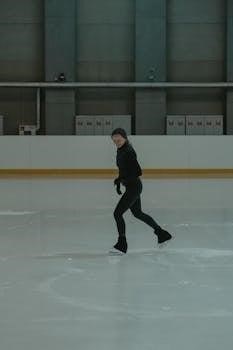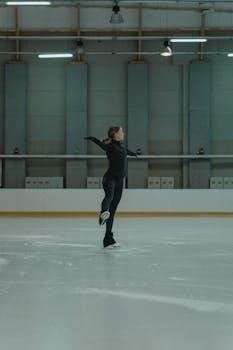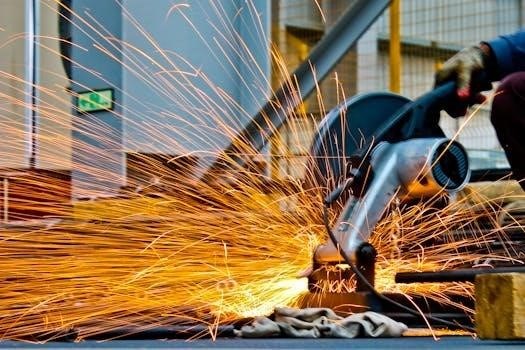
iliopsoas tendonitis exercises pdf
Understanding Iliopsoas Tendonitis
Iliopsoas tendonitis, also known as snapping hip syndrome or dancer’s hip, involves inflammation of the iliopsoas tendon or surrounding structures. This condition is frequently seen in athletes and dancers due to overuse or acute injury.
What is Iliopsoas Tendonitis?
Iliopsoas tendonitis is an inflammatory condition affecting the iliopsoas tendon, a band of connective tissue that attaches the iliopsoas muscle to the bone; This muscle plays a crucial role in hip flexion and trunk movement. Tendonitis occurs when the tendon becomes irritated and inflamed, often due to repetitive movements, overuse or acute injuries. This can lead to pain and discomfort in the hip and groin area. The condition is also sometimes referred to as snapping hip syndrome due to the sensation of snapping that some individuals may experience during hip movement. It’s important to differentiate this condition from other hip related issues such as greater trochanteric pain syndrome.

Causes and Risk Factors
Iliopsoas tendonitis often stems from overuse, repetitive hip movements, or acute injuries. Athletes and dancers are particularly susceptible due to the demands placed on their hip joints.
Overuse and Repetitive Movements
Repetitive motions, especially those involving hip flexion, can place significant stress on the iliopsoas tendon. Activities like cycling, walking, stair climbing, and kicking can contribute to inflammation and irritation. This is particularly common in individuals who engage in high-intensity sports or dance. The constant strain leads to micro-tears in the tendon, which, over time, can result in tendinitis. Insufficient rest and recovery between workouts exacerbate the issue. It’s crucial to understand how repetitive movements influence the tendon, and modify activities appropriately to promote healing, and reduce pain.
Acute Injury
An acute injury, such as a sudden forceful movement or a direct blow to the hip, can also lead to iliopsoas tendonitis. These types of injuries often occur during sports activities, or accidents. A sudden strain or trauma can cause immediate inflammation and pain in the iliopsoas tendon. The tendon can be irritated after hip replacement surgery. This can result in a sudden onset of symptoms, including pain in the front of the hip or groin. It is vital to seek prompt medical attention for acute injuries to prevent further complications, and aid in proper healing.
Symptoms of Iliopsoas Tendonitis
Common symptoms include intermittent groin pain, often described as a deep ache. Pain typically worsens with activity, especially kicking, and is relieved with rest. An audible snapping may also occur.
Pain Location and Characteristics
The pain associated with iliopsoas tendonitis is typically felt in the front of the hip or groin area. It’s often characterized as a deep, aching sensation that can sometimes feel like a pulled groin muscle. This discomfort tends to be intermittent, meaning it comes and goes, and is commonly exacerbated by activities that involve hip flexion, such as kicking or running. The pain can also be present during movements that require the hip flexors, and it usually improves with rest and decreased activity. The location is distinct from pain on the outside of the hip.
Audible Snapping Sensation
A hallmark symptom of iliopsoas tendonitis, often referred to as snapping hip syndrome, is the presence of an audible or palpable snapping sensation. This occurs as the iliopsoas tendon moves over bony structures in the hip joint during flexion and extension. The snapping might not always be painful, but it can become uncomfortable or even painful when inflammation is present. This sensation is typically felt at the front of the hip, and it is most noticeable when flexing or extending the hip. The snapping can be a key indicator for diagnosing this condition.

Conservative Treatment Approaches
Initial treatment often involves activity modification, relative rest, and exercises. Soft tissue manipulation and myofascial release may help reduce tightness within the iliopsoas muscle.
Activity Modification and Rest
Modifying activities is crucial in reducing strain on the iliopsoas tendon and promoting healing. It involves identifying and avoiding movements that aggravate the pain. Relative rest allows the inflamed tendon to recover by reducing repetitive stress. This may include taking breaks from high-impact activities like running or jumping. Substituting these with low-impact options such as swimming or cycling can help maintain fitness without further irritating the tendon. It’s essential to listen to your body and avoid pushing through the pain, to allow the tendon to heal properly and prevent further damage. Remember, gradual return to activity is key.

Physical Therapy Exercises
Physical therapy involves specific exercises to strengthen hip muscles, improve flexibility, and correct biomechanical imbalances. These exercises play a vital role in recovery and pain management.
Stretching Exercises for Iliopsoas
Stretching the iliopsoas muscle is crucial for relieving tightness and improving flexibility. These exercises typically involve moving the hip back into extension, behind the body. When performing stretches, it’s important to move slowly, and never push to the point of discomfort. Gentle stretches for the psoas can offer significant pain relief and increased mobility. One example includes kneeling with calves flat, hands on hips, and gently extending the hip. Consistency and proper form are key to effective stretching. These stretches may help address pain and discomfort from iliopsoas tendinopathy.
Strengthening Exercises for Hip Muscles
Strengthening the hip muscles is essential for supporting the iliopsoas tendon and improving overall stability; These exercises involve lifting the leg in front of the body. Examples include wall mini-squats, physioball mini-squats, and pool exercises, such as water walking. Strengthening exercises help correct biomechanical imbalances and reduce strain on the tendon. It’s important to start with low resistance and gradually increase as strength improves. These exercises are important for rehabilitation and can help prevent future issues. Consistency and proper form are key.
Eccentric Exercise in Rehabilitation
Eccentric exercises play a crucial role in rehabilitating iliopsoas tendinopathy. These exercises focus on lengthening the muscle under tension, aiding in tendon healing and functional recovery. They are a vital part of a progressive loading program.
The Role of Eccentric Training
Eccentric training is particularly beneficial in the rehabilitation of iliopsoas tendinopathy due to its capacity to stimulate tendon remodeling and improve tensile strength. This type of exercise involves lengthening the muscle while it is under tension, which can help to promote healing within the damaged tendon fibers. Incorporating eccentric exercises into a rehabilitation program, alongside other forms of therapy, can lead to improved function and reduced pain. It is a vital component for athletes and individuals seeking to return to their previous activity levels, by addressing the underlying tissue weaknesses of the iliopsoas muscle. These exercises should be carefully progressed with proper guidance.

Other Helpful Therapies
Soft tissue manipulation and myofascial release can help alleviate tightness within the iliopsoas muscle. These techniques can release adhesions and improve overall tissue mobility, promoting healing.
Soft Tissue Manipulation and Myofascial Release
These techniques are beneficial in addressing iliopsoas tendonitis by targeting the soft tissues surrounding the affected tendon. Myofascial release involves applying gentle, sustained pressure to release tension and restrictions within the fascia, the connective tissue that surrounds muscles. Soft tissue manipulation, on the other hand, uses various hands-on techniques to break down adhesions and improve mobility of the muscles, tendons and other soft tissues. These manual therapies can improve circulation, reduce pain, and help restore proper function, promoting the healing process and facilitating a return to normal activity levels. These approaches help alleviate pain from iliopsoas tendonitis.

